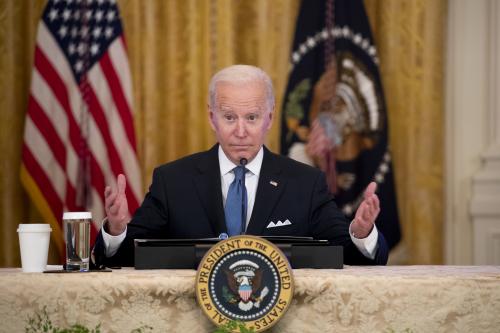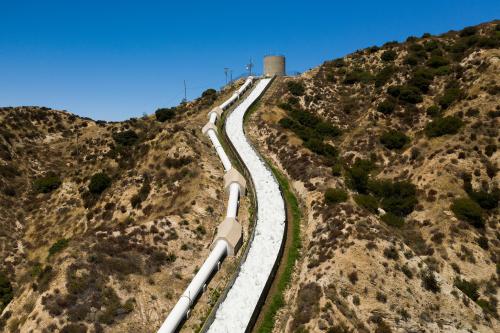It’s inevitable that every large government expenditure program will be accompanied by some waste, fraud, and abuse. That especially applies to the massive emergency expenditure bills such as the stimulus funding in response to the economic recession in 2009, the COVID pandemic relief spending in 2020, or the recent infrastructure spending bill in 2021. Coordinated oversight of these kinds of expenditures is therefore essential. This three-part series by Glenn Fine, the former inspector general for the Department of Justice and the acting inspector general for the Department of Defense, explores what we have learned about this fight in the past and what President Biden and Congress should do to deter waste, fraud, and abuse in the recently passed infrastructure spending bill. These articles discuss two previous models of coordinated oversight among inspectors general and the need for a similar model for infrastructure spending and any other future large expenditure programs. In the third article he makes four specific recommendations to enhance such oversight.
On November 15, 2021, President Biden signed into law another large expenditure bill, the $1.2 trillion infrastructure bill (“The Infrastructure Investment and Jobs Act”). This legislation authorized $550 billion in new funding for projects involving roads and bridges, improvements in water infrastructure, rail improvements, broadband internet and cybersecurity enhancements, replacement of hazardous lead pipes, port improvements, environmental projects, electric vehicle charging stations, and other infrastructure projects.
The Administration created a task force of federal officials to coordinate the disbursement of the money from multiple federal agencies. The President appointed former New Orleans Mayor Mitch Landrieu as the senior White House advisor responsible for coordinating the implementation of the law.
However, unlike the Recovery Act or the CARES Act, the bill did not provide for coordinated, independent oversight of this funding. The bill exhorted federal agencies “to establish sufficient transparency, accountability reporting and oversight measures” for specific programs (such as the digital equity grant program related to broadband). But as Professor Jetson Leder-Luis points out, the bill did not focus on the potential for fraud, and “the word fraud appeared only seven times in the 2000-page bill.”
The bill did authorize some additional funding for individual inspectors general. Some were given specified amounts, and others were authorized to be funded with one-half of one percent of the amounts authorized for their agencies under the infrastructure bill. But the bill did not create a central oversight mechanism to coordinate oversight of infrastructure spending, like the Recovery Board or PRAC. It did not even assign the existing PRAC responsibility for such oversight.
Infrastructure spending is a particularly fertile target for fraudsters. The Coalition for Public Integrity issued a comprehensive report when the infrastructure bill was being considered which stressed the need for robust oversight because of the scope, complexity, and cost of the infrastructure legislation. The report noted that without such oversight, infrastructure projects at all levels risked falling victim to fraud. For example, costs can be inflated and inferior products and materials can be substituted easily. Bids on infrastructure projects are also susceptible to collusion and bid rigging. The Boston’s Big Dig is perhaps the most well-known example of an infrastructure project replete with waste and fraud.
Individual inspectors general can provide oversight of infrastructure funds related to their agencies’ programs. But assigning responsibility for coordinating oversight, backed by an existing database system to make the expenditures more transparent and supported by data analytics tools, like the Recovery Board or the PRAC, would have been a prudent step in deterring inevitable fraud and waste in the large amounts of infrastructure spending. Unfortunately, that robust oversight model was not included in the legislation.
Recommendations
If additional large spending infrastructure legislation is enacted this year or in the future—such as the Build Back Better legislation, in whole or in part—the same challenges to deterring fraud, waste, and abuse will arise. This applies to other potential emergency expenditure bills in the future. I propose four recommendations to ensure better oversight of any such expenditures.
1. Make the PRAC a permanent entity
The infrastructure of the Recovery Board and the Pandemic Response Accountability Committee—particularly their public websites that transparently depict expenditures and their data analytics centers to mine risk factors for fraud—provide useful tools to help detect and deter fraud, waste, and abuse. If they lapse, it would be difficult, expensive, and slow to rebuild them. These tools also do not cost much to maintain when compared with the large amounts of expenditures from the federal government, the fraud and improper payments they can help prevent, and the substantial money they can help recover.
It was a mistake to let the Recovery Board’s data analytics center lapse in 2015. It would similarly be a mistake to let the PRAC’s rebuilt data analytic tools atrophy or disappear when pandemic spending recedes. The PRAC’s information technology tools and its infrastructure should be made permanent, and its coverage expanded.
These tools can also help individual inspectors general better detect fraud in non-emergency federal expenditures. While some large inspectors general have robust data analytics tools, others do not. Smaller inspectors general normally do not have the resources to create their own data analytic capabilities. The permanent availability of these tools would help inspector general oversight. And the public would benefit from transparent websites providing details of public expenditures, even beyond pandemic relief funds. The PRAC’s capabilities should therefore be permanently maintained with a regular appropriation.
2. Assign the PRAC responsibility for overseeing infrastructure spending
While a senior White House advisor, Mitch Landrieu, has responsibility for coordinating the dispersal of the infrastructure funds, independent coordinated oversight from watchdogs is also necessary. Individual inspectors general provide oversight of the funds dispersed by their agencies, consistent with their normal duties. But the infrastructure bill has multiple funding streams which cross agency lines. Mandated coordination among inspectors general would boost oversight efforts. This may occur naturally, on ad hoc basis, among some inspectors general, but there is no assurance that such coordination will be comprehensive or effective.
A defined structure assigning responsibility for coordinating oversight, like the Recovery Board and the PRAC, would improve oversight of infrastructure spending among many agencies. The experience of the Recovery Board, and now the PRAC, has demonstrated the benefits of that approach. The infrastructure bill missed a similar opportunity.
3. Ensure that a percentage of stimulus or infrastructure spending is appropriated for individual inspectors general for oversight
Individual inspectors general largely conduct the day-to-day work of investigating, detecting, and deterring fraud, whether in normal appropriations or in the massive amount of stimulus or infrastructure funding. But the recent large emergency expenditures have dramatically increased the demands on the inspectors general limited investigative and audit resources. Their individual offices are hard pressed to handle the added demands along with their existing duties.
Inspectors general have not consistently received adequate resources to manage increasing assignments. For example, the amount appropriated for each inspector general in the CARES Act and the infrastructure bill largely depended on varying views of individual inspector general offices by the Congressional committees responsible for funding different agencies. Some inspectors general were authorized additional funding in the stimulus or infrastructure bills. Others were not authorized additional or adequate funding in light of their increased responsibilities. And congressional authorization for funding inspectors general does not necessarily ensure that the money will actually be appropriated.
In general, a sound principle for setting resource levels for inspectors general would be an expectation that they should be allocated a small percentage of any additional expenditures their agencies receive. The percentage for inspectors general would not need to be large—certainly less than one half of one percent of overall spending increases for their agencies. The return on this investment, in terms of fraud averted and recoveries made, would be great.
For example, the annual report from the Council of the Inspectors General on Integrity and Efficiency (CIGIE), the coordinating group for all 75 federal inspectors general, discusses the combined results of the work of these inspectors general. CIGIE reported that for Fiscal Year 2020, all federal inspectors general had a combined budget of approximately $3.1 billion, and their work resulted in potential savings totaling approximately $53 billion, or a $17 return on every dollar invested in inspectors general. This potential savings included $19 billion in investigative receivables and recoveries. These numbers do not even account for increased efficiencies as a result of the many inspector general audits or evaluations of agency programs.
However, inspectors general cannot keep doing more with less. Even aside from overseeing the recent emergency expenditures, over time inspector general responsibilities have dramatically increased. And while the size of their agencies they oversee has grown, inspector general budgets have not grown a commensurate amount. That is not wise. I believe that a sound principle that should normally be followed is that if an agency’s budget grows by a certain percentage, the inspector general’s budget should grow by a similar percentage. If the agency’s budget is flat, the inspector general’s budget should also be flat, unless the inspector general is assigned additional responsibilities. And if an agency’s budget declines, the inspector general’s budget should also decline. That principle is not regularly followed, and inspector general budgets have often lagged behind the growth of their agencies’ budgets.
4. Fund CIGIE with a dedicated appropriations
The budget for CIGIE, the statutorily established organization of federal inspectors general, should be funded through a separate appropriation. CIGIE provides significant value in coordinating oversight, supporting individual inspector generals with necessary tools for oversight, enhancing training within the inspector general community, ensuring consistent audit and investigative standards among inspectors general, and handling complaints of misconduct against individual inspectors general. It also coordinates inspector general responses to issues of common concern, including the response to emergency funding, like the CARES Act or the infrastructure bill, which involve many agencies and inspectors general.
These are difficult tasks for CIGIE and they require resources. However, CIGIE does not have dedicated funding. Its budget largely relies on contributions and volunteer staffing from individual inspectors general. And the formula for funding CIGIE’s budget with contributions has been inconsistent. Some years, contributions come from the budgets of all inspectors general. Other years, contributions come from a subset of inspectors general. Each year, individuals inspectors general struggle to plan for this varying contribution level. CIGIE is also challenged in making long-term investments because of uncertain funding.
CIGIE needs a separate appropriation so that it can make long-term plans and investments to enhance oversight by inspectors general. For example, with a small, consistent appropriation, CIGIE could hire staff to ensure that oversight tools, like the Recovery Operations Center or the PRAC’s data analytics center, could be permanently maintained.
CIGIE should also have consistent resources for its other public databases, including Oversight.gov, which collects and makes transparent for the public and government officials reports from throughout the OIG community. CIGIE should have additional resources to provide more training and coordinated oversight efforts among inspectors general. And CIGIE should be given dedicated resources to hire additional staff for its Integrity Committee, which would allow it to investigate complaints of misconduct against inspectors general more effectively and in a timelier manner.
Again, the funding for CIGIE would not have to be large. I recognize that money for oversight by inspectors general—or for coordination of such oversight by CIGIE—is not the first thought when government expenditures are considered, either through special expenditures like stimulus or infrastructure funding or through regular appropriations. But small amounts for oversight—both for inspectors general individually and for CIGIE specifically—are a sound investment that would pay off greatly for taxpayers in both the short-term as well as the long-term.
Previous: oversight of pandemic spending
The Brookings Institution is committed to quality, independence, and impact.
We are supported by a diverse array of funders. In line with our values and policies, each Brookings publication represents the sole views of its author(s).







Commentary
Fighting fraud, waste, and abuse—the infrastructure bill and lessons for the future
February 11, 2022